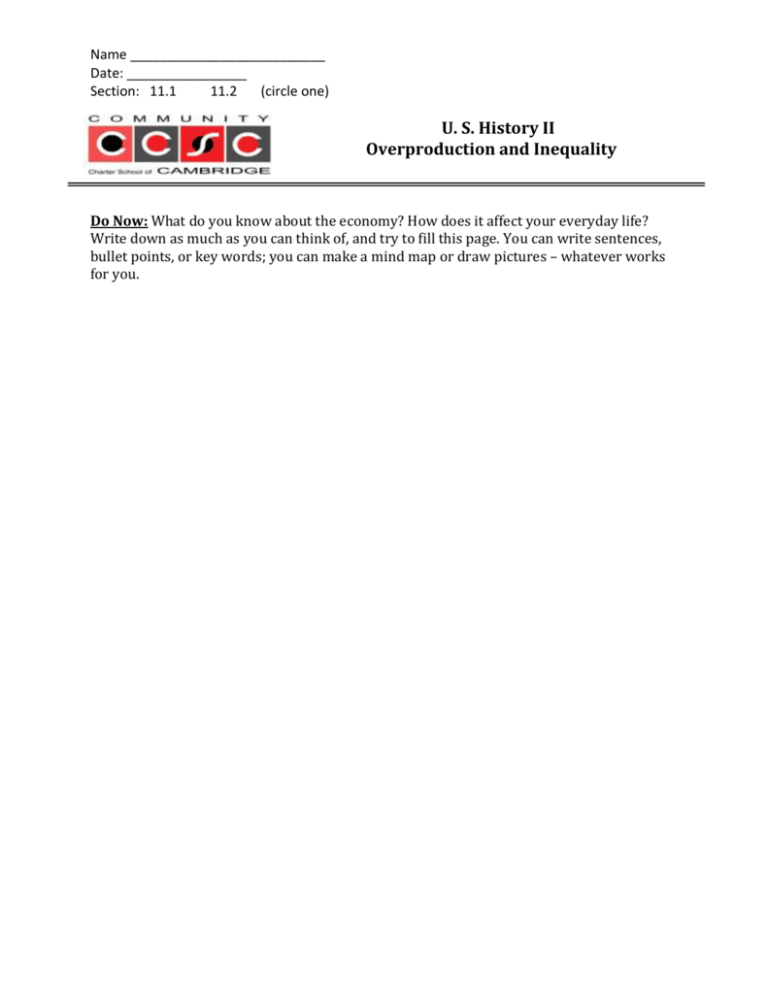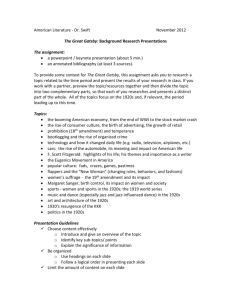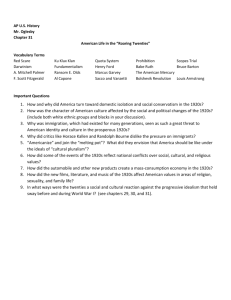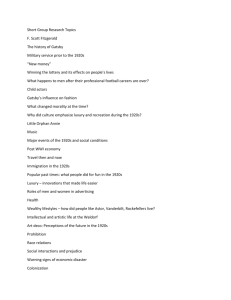
Name __________________________
Date: ________________
Section: 11.1
11.2
(circle one)
U. S. History II
Overproduction and Inequality
Do Now: What do you know about the economy? How does it affect your everyday life?
Write down as much as you can think of, and try to fill this page. You can write sentences,
bullet points, or key words; you can make a mind map or draw pictures – whatever works
for you.
Simulation Notes: Overproduction and Inequality
What happened in Round 1, when demand was much greater than supply?
Prices were:
Profits were:
Consumption (the number of pencils bought) was:
What happened in Round 2, when demand and supply were roughly equal?
Prices went:
Profits went:
Consumption went:
What happened in Round 3, when supply was much greater than demand?
Supply went:
Prices went:
Consumption went:
What happened in Round 4, when consumers had highly unequal wealth and high
confidence in the economy?
The market depended on…
Producers DID or DID NOT (circle one) make a profit, because…
What happened in Round 5, when consumers had highly unequal wealth and low
confidence in the economy?
The market depended on…
Producers DID or DID NOT (circle one) make a profit, because…
Name __________________________
Date: ________________
Section: 11.1
11.2
(circle one)
U. S. History II
HW 6.1: Overproduction and Inequality
Instructions: Carefully read the following text (source: Emma Lapsansky-Werner et al.,
United States History [Boston: Pearson Prentice Hall, 2008]). Then, answer the following
questions:
1. Why were farmers so vulnerable to economic problems during the 1920s? [At least
5 complete sentences]
2. What is underconsumption, and how did an unequal distribution of wealth
contribute to underconsumption in the 1920s? [At least 5 complete sentences]
3. What is ‘buying on credit’? What problems might arise from Americans
accumulating so much debt in the 1920s? [At least 3 complete sentences]
Overproduction in Agriculture
American farmers faced difficult times during the 1920s. Farmers made up one fourth of
the American workforce during the decade. To meet the unprecedented crop demands
created by World War I, they had increased harvest yields and bought more land to put
under the plow. They also bought costly tractors and other mechanized farm equipment.
Farmers contracted huge debts doing this, and the additional mortgage payments followed
them in to the 1920s.
After the war, the demand for American crops fell sharply. Between 1925 and 1929, nearly
every export crop in the world fell in price. Millions of farmers suffered losses as cash
commodities like coffee fell from 24 cents to 10 cents a pound or rice depreciated 30-50
percent in value. The problem was simple. There was too much agricultural production in
the 1920s–supply far outweighed demand. Despite this drop, postwar production
remained high because of increasingly mechanized farm equipment and more intensive
farming methods. Farms were getting bigger and experiencing good harvests.
Around the world, cotton production increased by 30 per cent; rubber production
increased by more than 80 per cent. The farming of wheat, beets, sugar cane, tea, and cocoa
was also amplified. Meanwhile governments placed tariffs on imported foodstuffs to
protect their own farmers. Germany, for example, more than tripled its wheat tariff
between 1925 and 1930. The sharp reduction in exports devastated agriculture worldwide.
The agricultural industry was still the backbone of the economies of many countries,
including the United States. Heavily in debt for land and machinery, farmers around the
globe were in trouble well before the Great Depression started.
However, farmers were failing to sell off their huge crop surpluses and pay their debts to
banks and other institutions.
The result was a rural depression that affected millions of Americans. Hard-pressed to pay
their debts, forced to sell in a glutted and competitive world market, and confronted by
several natural disasters, farmers did not share in the boom times of the 1920s. They did
not have the cash to buy the new consumer goods produced by American industries. They
lived largely on credit from month to month, often teetering on the brink of financial ruin.
Any downward slide in the economy was likely to hit America’s struggling farmers first and
hardest.
Unequal Distribution of Wealth
The 1920s in the United States are often linked in our historical memories to prosperity
and good times. Unlike farmers, industrial workers participated in the great national
success story. During the 1920s, their wages rose steadily, as did their disposable income.
Many purchased Model T Fords along with a variety of other consumer products. Though
they were certainly not wealthy, industrial laborers were in a better financial position than
their fathers had been a generation before.
But the problem was that while wages rose gradually, worker productivity increased
astronomically. Between 1923 and 1929, output per person-hour jumped 32%, but
workers’ wages inched up only 8%. During that same period, corporate profits from
worker output skyrocketed 65%. All these figures pointed to the fact that during the 1920s,
the rich became much, much richer, while industrial workers simply became less poor. 40
per cent of the country shared just 12 per cent of the national income by the end of the
decade. In contrast, the well-to-do who made up 5 per cent of the population enjoyed over
30 per cent of the national income.
This uneven distribution of the nation’s wealth created economic problems. More than 60
percent of all American families had yearly incomes of less than $2,000 per year. Twentyfour thousand of the country’s wealthiest families enjoyed annual incomes of more than
$100,000, which was 50 times more than what most families were earning. But these
wealthy families did not eat 50 times more food than lower-income families. The wealthiest
households did not purchase 50 times more automobiles or radios or ovens. The rich
undoubtedly spent a lot on consumer products. The problem was that the wealthiest few
did not buy enough to keep the economy booming.
A healthy economy needs more people to buy more products, which in turn creates even
more wealth. In this way, a healthy economy avoids underconsumption that can limit
economic growth. The uneven distribution of wealth in the 1920s pointed to an uncertain
future for the American economy.
From the overproduction of the struggling farmer to the underconsumption of the lowerincome industrial worker, deep-seated problems created economic instability. Too many
Americans did not have enough money to buy what they needed or wanted.
Easy Credit Hides Problems
For a time, the expansion of credit partially hid this problem. Americans bought
automobiles, appliances, radios, and other goods on credit. Using the installment plan, they
paid a small percentage down and the rest over a period of months or years. By the end of
the decade, 80 percent of radios and 60 percent of cars were purchased on installment
credit. Americans even bought stock on credit, making such stock purchases on margin.
Every year, Americans accumulated more debt. In the past, they had feared debt and put off
buying goods until they had the cash to pay for those items. However, easy credit changed
this behavior during the 1920s. The growing credit burden could mask the problem of
Americans living beyond their means for only so long before the economy imploded.










